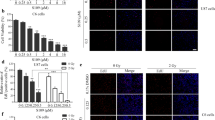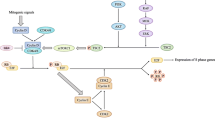Abstract
Radiation resistance is a major problem preventing successful treatment. Therefore, identifying sensitizers is vitally important for radiotherapy success. Epigenetic events such as DNA methylation have been proposed to mediate the sensitivity of tumor therapy. In this study, we investigated the influence of demethylating agent 5-Aza-2′-deoxycytidine (5-Aza-CdR) on the radiosensitivity of human osteosarcoma cell lines. 5-Aza-CdR was capable of sensitizing three osteosarcoma cells to irradiation in a time-dependent manner, with the maximum effect attained by 48 h. Pretreatment with 5-Aza-CdR synchronized cells in G2/M phase of the cell cycle and enhanced irradiation-induced apoptosis compared with irradiation alone in SaOS2, HOS, and U2OS cells. Moreover, 5-Aza-CdR restored mRNA expressions of 14-3-3σ, CHK2, and DAPK-1 in the three cells, accompanied with demethylation of their promoters. These findings demonstrate that demethylation with 5-Aza-CdR increases radiosensitivity in some osteosarcoma cells through arresting cells at G2/M phase and increasing apoptosis, which is partly mediated by upregulation of 14-3-3σ, CHK2, and DAPK-1 genes, suggesting that 5-Aza-CdR may be a potential radiosensitizer to improve the therapy effect in osteosarcoma.




Similar content being viewed by others
Abbreviations
- 5-Aza-CdR:
-
5-Aza-2′-deoxycytidine
- DNMT:
-
DNA methyltransferase
- IC20 :
-
Concentration to cause a 20 % reduction in cell proliferation
- GAPDH:
-
Glyceraldehyde-3-phosphate dehydrogenase
- D0 :
-
Dose to reduce survival to 37 %
- SF2:
-
Surviving fraction at 2 Gy
- SER:
-
Sensitizer enhancement ratio
References
Dai X et al. Review of therapeutic strategies for osteosarcoma, chondrosarcoma, and Ewing’s sarcoma. Med Sci Monit. 2011;17(8):RA177–90.
Ta HT et al. Osteosarcoma treatment: state of the art. Cancer Metastasis Rev. 2009;28(1–2):247–63.
Juergens RA, Rudin CM. Aberrant epigenetic regulation. Am Soc Clin Oncol Educ Book. 2013;2013:295–300.
Virani S et al. Cancer epigenetics: a brief review. ILAR J. 2012;53(3–4):359–69.
Mani S, Herceg Z. DNA demethylating agents and epigenetic therapy of cancer. Adv Genet. 2010;70:327–40.
Fathi AT, Abdel-Wahab O. Mutations in epigenetic modifiers in myeloid malignancies and the prospect of novel epigenetic-targeted therapy. Adv Hematol. 2012;2012:469592.
Shih AH et al. The role of mutations in epigenetic regulators in myeloid malignancies. Nat Rev Cancer. 2012;12(9):599–612.
Karahoca M, Momparler RL. Pharmacokinetic and pharmacodynamic analysis of 5-aza-2′-deoxycytidine (decitabine) in the design of its dose-schedule for cancer therapy. Clin Epigenetics. 2013;5(1):3.
Cho HJ et al. The combination effect of sodium butyrate and 5-Aza-2′-deoxycytidine on radiosensitivity in RKO colorectal cancer and MCF-7 breast cancer cell lines. World J Surg Oncol. 2009;7:49.
Brieger J et al. Pharmacological genome demethylation increases radiosensitivity of head and neck squamous carcinoma cells. Int J Mol Med. 2012;29(3):505–9.
Dunne AL et al. Relationship between clonogenic radiosensitivity, radiation-induced apoptosis and DNA damage/repair in human colon cancer cells. Br J Cancer. 2003;89(12):2277–83.
Li Y, Meng G, Guo QN. Changes in genomic imprinting and gene expression associated with transformation in a model of human osteosarcoma. Exp Mol Pathol. 2008;84(3):234–9.
Lal G et al. Regulation of 14-3-3sigma expression in human thyroid carcinoma is epigenetically regulated by aberrant cytosine methylation. Cancer Lett. 2008;267(1):165–74.
Ahmad ST et al. Methylation of the APAF-1 and DAPK-1 promoter region correlates with progression of renal cell carcinoma in North Indian population. Tumour Biol. 2012;33(2):395–402.
Wang H et al. Chk2 down-regulation by promoter hypermethylation in human bulk gliomas. Life Sci. 2010;86(5–6):185–91.
Dawson MA, Kouzarides T. Cancer epigenetics: from mechanism to therapy. Cell. 2012;150(1):12–27.
Qiu H et al. DNA methyltransferase inhibitor 5-aza-CdR enhances the radiosensitivity of gastric cancer cells. Cancer Sci. 2009;100(1):181–8.
Dote H et al. Enhancement of in vitro and in vivo tumor cell radiosensitivity by the DNA methylation inhibitor zebularine. Clin Cancer Res. 2005;11(12):4571–9.
De Schutter H et al. A systematic assessment of radiation dose enhancement by 5-Aza-2′-deoxycytidine and histone deacetylase inhibitors in head-and-neck squamous cell carcinoma. Int J Radiat Oncol Biol Phys. 2009;73(3):904–12.
Kim HJ et al. DNMT (DNA methyltransferase) inhibitors radiosensitize human cancer cells by suppressing DNA repair activity. Radiat Oncol. 2012;7:39.
Trougakos IP et al. Genome-wide transcriptome profile of the human osteosarcoma Sa OS and U-2 OS cell lines. Cancer Genet Cytogenet. 2010;196(2):109–18.
Gravina GL et al. Biological rationale for the use of DNA methyltransferase inhibitors as new strategy for modulation of tumor response to chemotherapy and radiation. Mol Cancer. 2010;9:305.
Begg AC, Stewart FA, Vens C. Strategies to improve radiotherapy with targeted drugs. Nat Rev Cancer. 2011;11(4):239–53.
Sinclair WK. Cyclic x-ray responses in mammalian cells in vitro. Radiat Res. 1968;33(3):620–43.
Shin DY et al. Decitabine, a DNA methyltransferases inhibitor, induces cell cycle arrest at G2/M phase through p53-independent pathway in human cancer cells. Biomed Pharmacother. 2013;67(4):305–11.
Jabbour E et al. Evolution of decitabine development: accomplishments, ongoing investigations, and future strategies. Cancer. 2008;112(11):2341–51.
Mhawech P et al. Downregulation of 14-3-3sigma in ovary, prostate and endometrial carcinomas is associated with CpG island methylation. Mod Pathol. 2005;18(3):340–8.
Schultz J et al. 14-3-3sigma gene silencing during melanoma progression and its role in cell cycle control and cellular senescence. Mol Cancer. 2009;8:53.
Hermeking H, Benzinger A. 14-3-3 proteins in cell cycle regulation. Semin Cancer Biol. 2006;16(3):183–92.
Steiner M et al. 14-3-3sigma mediates G2-M arrest produced by 5-aza-2′-deoxycytidine and possesses a tumor suppressor role in endometrial carcinoma cells. Gynecol Oncol. 2012;127(1):231–40.
Schildhaus HU et al. Promoter hypermethylation of p16INK4a, E-cadherin, O6-MGMT, DAPK and FHIT in adenocarcinomas of the esophagus, esophagogastric junction and proximal stomach. Int J Oncol. 2005;26(6):1493–500.
Leung RC et al. Promoter methylation of death-associated protein kinase and its role in irradiation response in cervical cancer. Oncol Rep. 2008;19(5):1339–45.
Bar-Sela G, Jacobs KM, Gius D. Histone deacetylase inhibitor and demethylating agent chromatin compaction and the radiation response by cancer cells. Cancer J. 2007;13(1):65–9.
Ljungman M. The influence of chromatin structure on the frequency of radiation-induced DNA strand breaks: a study using nuclear and nucleoid monolayers. Radiat Res. 1991;126(1):58–64.
Rogakou EP et al. DNA double-stranded breaks induce histone H2AX phosphorylation on serine 139. J Biol Chem. 1998;273(10):5858–68.
Tashiro S, Sun J. Ionizing radiation-induced DNA damage and repair. Nihon Rinsho. 2012;70(3):383–7.
Acknowledgments
This study was funded by the National Natural Science Foundation of China (81201756) and Natural Science Foundation Project of YN CSTC (2011FZ316 and 2012FD090).
Author information
Authors and Affiliations
Corresponding author
Additional information
Yi Li and PeiLiang Geng contributed equally to this work.
Rights and permissions
About this article
Cite this article
Li, Y., Geng, P., Jiang, W. et al. Enhancement of radiosensitivity by 5-Aza-CdR through activation of G2/M checkpoint response and apoptosis in osteosarcoma cells. Tumor Biol. 35, 4831–4839 (2014). https://doi.org/10.1007/s13277-014-1634-5
Received:
Accepted:
Published:
Issue Date:
DOI: https://doi.org/10.1007/s13277-014-1634-5




